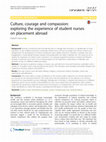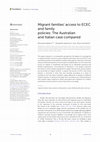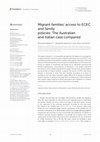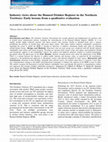Papers by Elizabeth Adamson
Oxford University Press eBooks, Feb 23, 2023

Journal of Compassionate Health Care, 2018
Background: Nursing is emotional work and learning how to manage their emotions is a valuable par... more Background: Nursing is emotional work and learning how to manage their emotions is a valuable part of nurse education. As the workforce becomes increasingly mobile nurses will care for people from diverse cultures and backgrounds. The development of cultural competence and a global mind-set is therefore a valuable asset and engagement in study abroad through overseas clinical placement can help to facilitate this. This study set out to explore the experience of student nurses involved in an exchange programme between Scotland and Western Australia. A particular focus was on the emotional aspects of the experience, responding to challenges and provision of care in a different healthcare setting. Methods: A descriptive qualitative strategy of enquiry was used and semi structured interviews undertaken with a sample of 10 student nurses using emotional touch points. The interviews were recorded, transcribed verbatim and subjected to thematic analysis using NVIVO 11. Results: Five main themes were identified. Making it happen, connections, feeling vulnerable, culture and assertiveness and affirmation. Conclusions: This study makes a unique contribution to the nursing student experience of overseas placement as it focuses on the emotional elements. The study shows that the experience of care delivery in an overseas placement has many benefits but also challenges. Management of emotion is required and transition to a different healthcare system can be stressful. Cultural differences were more marked than anticipated but when students responded by questioning, respectful assertiveness and provision of compassionate care there were clear rewards. These manifested as a sense that caring is a privilege and affirmation of career choice.
The purpose of this article is to examine trends in 'middle class welfare' in Australia, defined ... more The purpose of this article is to examine trends in 'middle class welfare' in Australia, defined in various ways, including the extent of cash transfers going to working age families with incomes above the second decile in the distribution of family incomes, the middle 50 per cent, and the richest 20 per cent of working age families. We use nationally representative income survey data for selected years between 1982 and 2007-08. We find that while according to this definition there was an increase in 'middle class welfare' between 1982 and 2007-08, this was relatively modest, and was focused on families not far above the second decile. We conclude that difficulties associated with tighter targeting of mean tested payments in an already tightly targeted system would achieve little in terms of increased efficiency and would likely cause considerable pain.

Frontiers in Education
IntroductionThe existing funding architectures for early childhood education and care (ECEC) serv... more IntroductionThe existing funding architectures for early childhood education and care (ECEC) services in Australia are incompatible with the needs of remote and First Nations communities. The Australian system relies on a market-based model for ECEC – characterized by demand-led funding mechanisms where funding flows to users to choose what service to use. This model is not viable or sustainable in remote and First Nations communities. In this paper, we ask what we can learn from alternative models of ECEC that serve remote, largely Indigenous communities.MethodsThis research is based on interviews with 10 key stakeholders. Potential participants were identified using three selection criteria which established their expertise in relation to: advocacy and experience in delivering ECEC services in remote locations (evident in relevant parliamentary reviews and inquiries), in-depth knowledge about First Nations perspectives about ECEC models, and broader understandings of the ECEC syst...
We also thank and acknowledge our colleague, Kirk Dodd, who devised the image of the cost cylinde... more We also thank and acknowledge our colleague, Kirk Dodd, who devised the image of the cost cylinders that appears in the report. Suggested citation Brennan, D., & Adamson, E. (2014) Financing the Future: An equitable and sustainable approach to early childhood education and care, SPRC Report 01/14,
Designing Social Service Markets: Risk, Regulation and Rent-Seeking
Family day care educators are also known as family day carers or 'childminders' in the United Kin... more Family day care educators are also known as family day carers or 'childminders' in the United Kingdom. In Australia, as part of a move towards professionalising the sector (Cook et al. 2013), all childcare workers, including those in family day care, are referred to by the term 'educators' if they work directly with children to provide early education and care.
This project reviewed policy and research about family day care and home-based childcare in New Z... more This project reviewed policy and research about family day care and home-based childcare in New Zealand and the United Kingdom. It examined the structure, funding and regulation of home-based child care and recent policy developments, investigating the implications for the accessibility, affordability and quality of early childhood education and care (ECEC) services. In addition, the project reflected on the relevance of international models for Australian family day care services.

Australia's population is ageing. Women are much more likely than men to live in poverty in o... more Australia's population is ageing. Women are much more likely than men to live in poverty in old age, especially single women (AHRC, 2010). Improving the economic security of single older women is a policy priority. It is also an important objective for financial advisors. Most research into the reasons behind single older women’s economic insecurity focuses on the ‘motherhood penalty’: the effects of having and rearing children on labour market participation, incomes and retirement incomes. In Australia, however, 16 per cent of women do not have children (Koropeckyj-Cox & Call 2007) and this proportion is growing. Little is known about older single women who do not have children, including how they are faring leading up to and after retirement and to what extent, when children are removed from the equation, gender inequalities persist. This report presents the results of new research, providing a detailed picture of what shapes the financial security and wellbeing of older single women without children (whom for the purposes of this project we will call older SWWC). Funded by CPA Australia, the research asks: How are older SWWC faring in employment, superannuation, housing and aged care? How does this compare with other gender and relationship groups? How can public policies support SWWC to obtain financial security in later life? How can accountants/financial advisors support SWWC to navigate these systems? To answer these questions, the report draws on a review of national legislation, analysis of Australia’s Household, Income and Labour Dynamics in Australia (HILDA) Survey, an online community with 45 older SWWC, and interviews with 10 financial stakeholders (i.e. financial advisors and housing specialists). Findings will inform policy and practice of governments and the financial services sector
The Social Policy Research Centre (SPRC) was commissioned by Family Day Care Australia to conduct... more The Social Policy Research Centre (SPRC) was commissioned by Family Day Care Australia to conduct research into quality in family day care. Six high quality services agreed to participate in the study. At each service, the SPRC research team conducted interviews with families, educators, coordination unit staff and representatives from managing organisations, comprising a total of 44 interviews with 52 people. All interviewees were strongly committed to providing quality early childhood education and care (ECEC) and had a belief in family day care’s unique strengths. The interviews explored ideas about the distinctive nature of quality in family day care, strengths and challenges, and how quality can be best supported. The data was analysed to reveal common themes across the services.
Every child, 2015
In 2013, ECA and Goodstart commissioned us to write a report on options for financing early child... more In 2013, ECA and Goodstart commissioned us to write a report on options for financing early childhood education and care (ECEC).

Policy Press, 2017
Once considered the preserve of the wealthy, nanny care has grown in response to changes in the l... more Once considered the preserve of the wealthy, nanny care has grown in response to changes in the labour market, including the rising number of mothers with young children, and increases in non-standard work patterns. This book examines the place of in-home childcare, commonly referred to as care by nannies, in Australia, the United Kingdom and Canada since the 1970s. In contrast to childminding or family day care provided in the home of the carer, in-home care takes place in the child’s home. The research extends beyond the early childhood education and care domain to consider how migration policy facilitates the provision of childcare in the private home. New empirical research is presented about in-home childcare in Australia, the United Kingdom and Canada, three countries where governments are pursuing new ways to support the recruitment of in-home childcare workers through funding, regulation and migration. The compelling policy story that emerges illustrates the implications of ...

Australian Journal of Social Issues, 2017
Migrants are important both as providers and users of paid care services in Australia, yet migrat... more Migrants are important both as providers and users of paid care services in Australia, yet migration has rarely featured in Australian strategies to grow and sustain the paid care workforce. Correspondingly, Australia is rarely mentioned in the international scholarship on care and migration that has burgeoned since the 1990s. This article shows the ways that service providers, consumer advocates, unions and scholars have begun to bring migration into debates about workforce growth in two of Australia's most significant areas of paid care: aged care and childcare. Drawing on submissions to national enquiries in both areas, we identify the actors who have sought to adjust Australia's migration settings to respond to growing demand for care, and explain the rationaleswhich differ between the sectorsunderlying their advocacy for change. K E Y W O R D S aged care, carers, childcare, migration and employment, social policy 1 | INTRODUCTION Demand for high-quality paid care services is increasing in wealthy nations. Like other countries, Australia is grappling to promote service quality and access while containing costs in two rapidly growing areas of social care: aged care and childcare (National Commission of Audit, 2014; Commonwealth of Australia, 2015, 2016). This paper is concerned with the extent to which Australia's migrant intake could provide the labour needed to support workforce growth in these care industries. Whereas other wealthy countries have managed growth by promoting flows of overseas workers into the paid care workforce, this has not been an explicit policy aim in
The framework is designed to establish consistent reporting requirements from key components of t... more The framework is designed to establish consistent reporting requirements from key components of the action plan to assess the extent to which the plan has met its objectives of improving the safety, welfare and wellbeing of children in NSW, why aspects of the reform ...

Frontiers in Sociology
This paper analyses in a comparative perspective the degree of convergence in migrant families... more This paper analyses in a comparative perspective the degree of convergence in migrant families' access to early childhood education and care (ECEC) and work/family policies in two different welfare state regimes: Italy and in Australia. Using a framework based on the concept of conditionality—or the notion that access to support is conditional and based on an individual's personal and familial characteristics, circumstances or behaviors—-the analysis examines the extent to which policies designed to support families with young children are accessible to migrant families. It argues that access to ECEC and family policies is restricted in both Italy and Australia according to a series of conditions, but that these conditions apply differently to people of different migrant statuses. In doing so the paper aims to improve our understanding of how welfare states respond to needs associated with migration for children and families and the extent to which they tend to converge.

Frontiers Sociology, 2022
This paper analyses in a comparative perspective the degree of convergence in migrant families' a... more This paper analyses in a comparative perspective the degree of convergence in migrant families' access to early childhood education and care (ECEC) and work/family policies in two di erent welfare state regimes: Italy and in Australia. Using a framework based on the concept of conditionality-or the notion that access to support is conditional and based on an individual's personal and familial characteristics, circumstances or behaviors-the analysis examines the extent to which policies designed to support families with young children are accessible to migrant families. It argues that access to ECEC and family policies is restricted in both Italy and Australia according to a series of conditions, but that these conditions apply di erently to people of di erent migrant statuses. In doing so the paper aims to improve our understanding of how welfare states respond to needs associated with migration for children and families and the extent to which they tend to converge.

Parents of one in six children were struggling to access child care services in 2014, with just o... more Parents of one in six children were struggling to access child care services in 2014, with just over one half of parents indicating that a failure to secure child care was hindering their ability to meet work commitments, according to this report. Summary In its 2014 review of the child care sector, the Productivity Commission revealed that parents of one in six children were struggling to access child care services in their area, with just over one half of parents indicating that a failure to secure child care was hindering their ability to meet work commitments. Most policy makers would now accept that an improvement in the availability and affordability of child care services would result in an improvement in Australia’s participation rate. However, it is important that policy makers do not lose sight of the fundamental shift that has occurred in recent years, as countries have moved from viewing childcare as simply child minding to viewing it as an important educational service ...

Drug and Alcohol Review, 2020
Introduction and Aims. The Northern Territory Government has recently planned and implemented an ... more Introduction and Aims. The Northern Territory Government has recently planned and implemented an extensive suite of alcohol harm minimisation policies, including the reintroduction of the Banned Drinker Register (BDR). It is an explicit alcohol supply reduction measure that places persons who consume alcohol at harmful levels onto a register, prohibiting the purchase of alcohol from takeaway liquor outlets. This paper explores industry stakeholders' perspectives regarding the extent to which the BDR is meeting its objectives to improve community health and safety by reducing alcohol-related harms. Design and Methods. Interviews and one focus group were conducted with 66 alcohol industry stakeholders from urban and remote locations. Focusing on outcomes both central (crime and safety) and peripheral (health and therapeutic support) to the stakeholders' interest, the authors used inductive thematic analysis to examine participants' perceptions about the effectiveness of the BDR. Results. Analysis revealed mixed views about the effectiveness of the BDR. There is a tension between the objective to address public amenity and decrease crime, as expressed by the participants, compared to the health-focused approach to therapeutic services and referrals identified in other sources. Discussion and Conclusions. Drawing on these findings, alongside other relevant sources, the authors argue there is a need for a more effective communication strategy to the public and professional community to enhance the capacity of the BDR to meet its goals. The authors recognise the limitations of alcohol industry stakeholder views and identify the need for a comprehensive evaluation approach that includes multiple stakeholder perspectives. [Adamson E, Clifford S, Wallace T, Smith JA. Industry views about the Banned Drinker Register in the Northern Territory: Early lessons from a qualitative evaluation. Drug Alcohol Rev 2020]
Uploads
Papers by Elizabeth Adamson